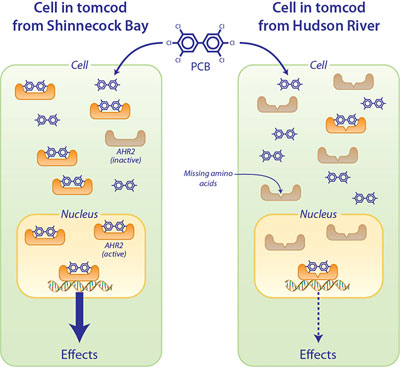This Stuff is somewhat scary
Seems a little messing with mother nature and any other consequences be damned…. Thoughts?
Genetic mutation helps fish resist PCBs
Friday, February 18, 2011, 23:40 (GMT + 9)
Researchers discovered that Atlantic tomcod (Microgadus tomcod) have developed a genetic mutation that lets them flourish in the Hudson Rivers waters heavily polluted with PCB.
In a study published this week in Science, a research group headed by a scientist from the New York University (NYU) School of Medicine described how this population of fish evolved to the presence of toxic chemicals – PCBs, or polychlorinated biphenyls – which were first dumped into the Hudson River in 1929 before being banned 50 years later.

"We’ve found evolutionary change going on very quickly due to toxic exposure, and just one gene is responsible for it," stated Isaac Wirgin, a population geneticist, associate professor of environmental medicine at NYU School of Medicine and leader of the study. "There are not many examples of this in the scientific literature."
Tomcod from the Hudson River have a variant protein that makes them less sensitive to the toxic effects of PCBs. The effects of PCBs occur through their interaction with a protein called Aryl Hydrocarbon Receptor 2 (AHR2). AHR2 is normally inactive, but when PCB molecules bind to it, AHR2 becomes activated and acts as a molecular switch to turn on other genes that lead to toxicity (Effects in the figure). Tomcod such as those from Shinnecock Bay, Long Island, NY (left panel) have a normal version of the AHR2 protein, which has a high affinity for PCBs. Tomcod from the Hudson River (right panel) have a variant AHR2 protein that is missing two amino acids (building blocks of proteins). Without these two amino acids, the AHR2 from Hudson River fish has a reduced ability to bind PCBs as compared to the normal AHR2 protein. This makes the Hudson River fish less sensitive to the effects of PCBs. (Illustration by Jack Cook, Woods Hole Oceanographic Institution)
From 1947 to 1976, General Electric poured some 1.3 million lb of PCBs into the Hudson River, where Atlantic tomcod is a common bottom-feeding fish not normally used for human consumption. It has been observed for a long time that the fish survives exposure to the toxic chemicals, and their levels are some of the highest reported in wildlife.
Yet, how tomcod could survive living amid concentrated PCBs instead of dying off like other species had remained inscrutable.
Wirgin and other researchers working at the National Oceanic and Atmospheric Administrations (NOAA) Fisheries Service (NMFS) and the Woods Hole Oceanographic Institution (WHOI) collected tomcod for four years from both polluted and relatively uncontaminated areas of the Hudson River in the winter, during the fishs spawning season. The tomcod were then screened for genetic variants in a gene – the aryl hydrocarbon receptor2 (AHR2) – encoding a protein that regulates PCBs toxic effects.
The study found that small alterations in the gene appear to shield the fish from PCBs.
Because tomcod from cleaner waters were found to occasionally possess mutant AHR2, these variants might have existed in minor proportions before PCBs were introduced into the Hudson River, Wirgin told. The fish would then have had an advantage over other species that suffered lethal heart defects in juveniles when the PCBs were released into their environment.
This advantage may have caused genetic changes in tomcod over some 50 years, the findings suggest.
Mark Hahn works in lab with colleague Diana Franks.(Tom Kleindinst, WHOI)
"We think of evolution as something that happens over thousands of generations," noted Wirgin. "But here it happened remarkably quickly."
The bad news is that, in exchange for the protection against PCBs, the fish are probably experiencing slower growth or lower resistance to other environmental stresses, Discovery reports.
And notably, the tomcod are allowing PCBs to penetrate the food chain.
"They serve as a prime prey for striped bass," Wirgin said. "You’ve got this fish that would normally be dead from PCBs or dioxin. It’s alive and it’s carrying around all this PCB and dioxin and it gets eaten."
By Natalia Real
editorial@fis.com
www.fis.com
Sport Fishing Forums – Offshore Big Game Fishing News Click Here
——-





